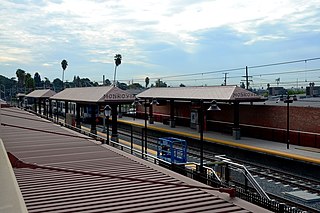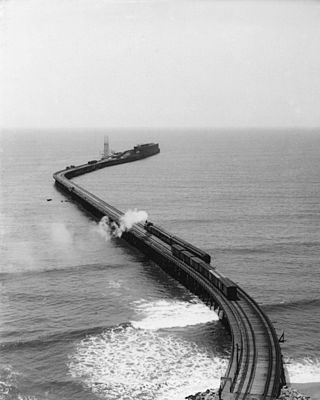
The Atchison, Topeka and Santa Fe Railway, often referred to as the Santa Fe or AT&SF, was one of the largest Class 1 railroads in the United States.

Atchison, Topeka and Santa Fe 3751 is a class "3751" 4-8-4 "Heavy Mountain" type steam locomotive built in May 1927 by the Baldwin Locomotive Works in Eddystone (Philadelphia), Pennsylvania for the Atchison, Topeka & Santa Fe Railway (ATSF). No. 3751 was the first 4-8-4 steam locomotive built for the Santa Fe and was referenced in documentation as type: "Heavy Mountain", "New Mountain", or "Mountain 4-wheel trailer". No. 3751 served in passenger duties until being retired in 1957.

The California Southern Railroad was a subsidiary railroad of the Atchison, Topeka and Santa Fe Railway in Southern California. It was organized July 10, 1880, and chartered on October 23, 1880, to build a rail connection between what has become the city of Barstow and San Diego, California.
Fred Thomas Perris was Chief Engineer of the Atchison, Topeka, and Santa Fe Railway, who oversaw the construction of the last leg of the 2nd Transcontinental Railroad from Barstow, California through Cajon Pass and down to San Bernardino and Los Angeles, a task that employed six thousand laborers and is still in use by BNSF Railway and Union Pacific Railroad He also laid track from Riverside, California to San Diego, California, laying out a series to town sites along the track, one of which, Perris, California was named in his honor. The city of Perris, California, a station on the California Southern Railroad, was named in his honor.(Its Cajon Pass. Not El Cajon Pass according to Chard Walkers "Cajon. Rail Passage To The Pacific")

Claremont station is a passenger rail and bus station in Claremont, California, United States. It is served by Metrolink's San Bernardino Line which runs from Los Angeles Union Station to San Bernardino–Downtown. The Mission Revival-Spanish Colonial Revival style station is listed on the U.S. National Register of Historic Places as Atchison, Topeka and Santa Fe Railroad Station.

The San Bernardino Santa Fe Depot is a Mission Revival Style passenger rail terminal in San Bernardino, California, United States. It has been the primary station for the city, serving Amtrak today, and the Santa Fe and Union Pacific Railroads in the past. Until the mid-20th century, the Southern Pacific Railroad had a station 3/4 of a mile away. It currently serves one Amtrak and two Metrolink lines. The depot is a historical landmark listed on the National Register of Historic Places as Atchison, Topeka and Santa Fe Railway Passenger and Freight Depot.
The Pasadena Subdivision is the remnant branch line of the former Atchison, Topeka and Santa Fe Railway (AT&SF) Los Angeles Second District. The line currently branches off of Metrolink’s San Bernardino Line at CP Cambridge in Claremont. The line follows a generally east–west alignment, passed through the cities of Claremont, Pomona, La Verne, San Dimas, Glendora, and Azusa before coming to a truncated end in Irwindale. For most of its length, it shares the corridor with the Los Angeles Metro Rail’s A Line. Recent construction, known as the Foothill Extension Phase 2B, has seen the tracks out of service west of San Dimas for most of 2021.

The Southern Transcon is a main line of BNSF Railway comprising 11 subdivisions between Southern California and Chicago, Illinois. Completed in its current alignment in 1908 by the Atchison, Topeka and Santa Fe Railway, when it opened the Belen Cutoff in New Mexico and bypassed the steep grades of Raton Pass, it now serves as a mostly double-tracked intermodal corridor.

Monrovia station is an at-grade light rail station on the A Line of the Los Angeles Metro Rail system. It is located at the intersection of Duarte Road and Myrtle Avenue in Monrovia, California, after which the station is named. This station opened on March 5, 2016, as part of Phase 2A of the Gold Line Foothill Extension Project.

Irwindale station is an at-grade light rail station on the A Line of the Los Angeles Metro Rail system. It is located at the intersection of Irwindale Avenue and Avenida Padilla in Irwindale, California, after which the station is named. This station opened on March 5, 2016, as part of Phase 2A of the Gold Line Foothill Extension Project.

The Los Angeles and San Gabriel Valley Railroad was a railroad founded on September 5, 1883, by James F. Crank with the goal of bringing a rail line to Pasadena, California from downtown Los Angeles, the line opened in 1886. Los Angeles and San Gabriel Valley Railroad was sold and consolidated on May 20, 1887 into the California Central Railway. In 1889 this was consolidated into Southern California Railway Company. On Jan. 17, 1906 Southern California Railway was sold to the Atchison, Topeka and Santa Fe Railway and called the Pasadena Subdivision. The main line closed in 1994. The railroad later reopened as the MTA Gold Line Light Rail service in July 2003.

The California Central Railway was incorporated on April 23, 1887, with headquarters in San Bernardino, California. George O. Manchester was the President of the corporation.

Redondo Junction, California is the site of an Amtrak maintenance facility. It is located 3.5 miles (5.6 km) south of Los Angeles Union Station, southwest of Boyle Heights near Washington Boulevard and the Los Angeles River.

The Long Wharf in Santa Monica, also known as Port Los Angeles or the Mile Long Pier, was an extensive pier wharf constructed by the Southern Pacific Railroad Company in Santa Monica Bay from 1892 to 1894. When it opened in 1894, it was the longest wharf in the world, measuring approximately 4,700 feet (1,400 m). It served as a cargo and passenger port until 1913, and in 1919 removal of the wharf started. The wharf, the 1,000 foot (300 m) tip of the pier, was removed by 1920. The remaining 3,600 feet (1,100 m) of pier was used as a run down fishing pier until 1933, when the remainder of the pier was removed. One of the major imports to the wharf was lumber from Northern ports, to help in the construction boom in Southern California. Southern Pacific Railroad and the street cars of the Los Angeles Pacific Railroad served the wharf. Los Angeles Pacific Railroad ran passenger trams to the wharf and from midnight to sunrise ran cargo cars.

Port Ballona is an archaic place name for an area near the center of Santa Monica Bay in coastal Los Angeles County, where Playa Del Rey and Del Rey Lagoon are located today. Port Ballona was a planned harbor and town site from circa 1859 to 1903. The name comes from the Rancho La Ballona Mexican land grant.

The Venice–Inglewood Line is a former railway line in Los Angeles County, California. The route was established by the Atchison, Topeka and Santa Fe Railway in 1887 before eventually being absorbed into the Pacific Electric interurban railway system. Service under electrification was very sparse, providing a suburban route between Venice and Inglewood.

The Inglewood depot in Inglewood, California, was built by Atchison, Topeka and Santa Fe Railway in September 1887. From 1902 to 1928 it was used for the Venice–Inglewood Line of the Los Angeles Railroad Pacific Electric Railway Depot, and then for Southern Pacific freight cars until the 1970s when the line was abandoned. The depot appeared in a 1920 Buster Keaton short called One Week, in Harold Lloyd's Safety Last! (1923), and it remained a popular filming location for decades.















